Beyond IPv4: Addressing for the Future
Read Our Guide
Beyond IPv4: Addressing for the Future
Addressing The Internet
Internet Protocol (IP) is the foundation that allows interconnected devices to communicate and transmit data across the internet. Similar to a telephone number, a connected device requires a unique IP address to ensure proper routing of information.
There are two versions of the Internet Protocol in use today – IPv4 and IPv6. Due to its global adoption in 1981, IPv4 remains the most commonly used address protocol and the backbone of business network infrastructure. Its successor, IPv6, was developed to address the rapid growth of the internet and the need for more IP addresses.
With the explosion of internet-connected devices (e.g., mobile phones, cars, smart TVs, and appliances), it was predicted that the IPv4 address space would soon be exhausted and so, IPv6 was born.
What are Some Examples of IPv6 Usage?
In 2008, the number of devices connected to the internet exceeded the global population. This growth is primarily due to the Internet of Things (IoT). Imagine a modern-day connected home with phones and tablets for the entire family, smart appliances, alarms and other devices, easily consuming a dozen IP addresses or more. With IPv6 adoption stemming mainly from mobile devices, IPv4 is still the foundation for the majority of the business done on the internet.
Download the full guide to keep reading how KickFire is expanding its TWIN Caching® technology beyond IPv4 to discover business intelligence within IPv6.
